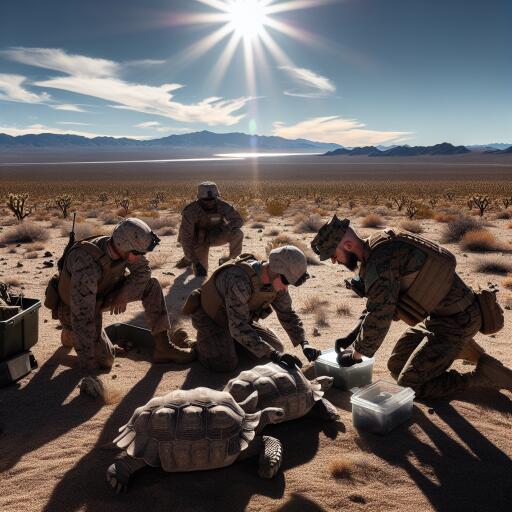
‘Gitmo’ in the Mojave: How the Marines are Saving Endangered Desert Tortoises
The quiet vastness of the Mojave Desert belies a small but significant operation aimed at conserving a vital keystone species: the desert tortoise. Nestled within the expansive Marine Corps Air Ground Combat Center in Twentynine Palms, California, the tortoise sanctuary is a critical effort to safeguard these unique creatures from numerous threats.
Emerging from their burrows with the quiet hope of a meal, two small tortoises respond to the approach of their caretaker, Brian Henen. Like a miniature fortress under the desert sun, their habitat—encircled by barbed wire and protected by netting—offers refuge from both natural predators and the mechanized chaos of military training exercises.
This sanctuary, colloquially dubbed “Tortoise Gitmo” or “Tortoise Bordello,” officially known as the Tortoise Research and Captive Rearing Site, represents a concerted effort to bolster tortoise populations amidst the pressures of human encroachment, disease, and climate shifts. Established in 2005, it aims to protect young tortoises until their shells develop strong enough to withstand predation.
In a unique environmental initiative, Henen and his team engage in a practice known as “head-starting”—raising hatchlings to an age where they can survive the harsh desert environment on their own. The expansion of the base in 2017 complicated matters but also expanded the scope of the sanctuary. Military exercises necessitated the relocation of tortoises, and 550 of them were integrated into the head-start program. Research also involves breeding studies to observe interactions between relocated tortoises and their new neighbors.
Yet, not everyone agrees with the method. Critics suggest that this approach distracts from addressing broader conservation needs. Ed LaRue of the Desert Tortoise Council argues for more concerted efforts on public lands to truly protect and repatriate tortoise habitats instead of focusing solely on military expansions.
Despite differing opinions, Henen emphasizes the significance of the program’s role in supplementing tortoise numbers and facilitating valuable long-term studies. Furthermore, a coalition of agencies is actively involved in conserving external lands under the Marines’ purview. In addition, 43,800 acres within the base boundaries have been earmarked as protected areas to preserve valuable tortoise habitat.
Training Marines on interacting with tortoises is another layer of this comprehensive initiative. If a tortoise appears in the training grounds, all activity halts until necessary procedures, guided by environmental specialists, ensure the animal’s safety. The presence of tortoises is taken so seriously that it can disrupt military exercises, underscoring the commitment to their protection.
Over decades, the once-abundant desert tortoise has faced drastic population declines of up to 96% in certain California areas due to urbanization, road construction, climate change, and invasive species. These threats have led to their reclassification from threatened to endangered—a stark reminder of their perilous situation.
Habitat fragmentation has made it difficult for tortoises to maintain healthy genetic diversity, while climate change-induced drought affects their water sources. Livestock and invasive plant species further decimate their natural diet. Ravens, now ubiquitous due to human-provided resources, prey relentlessly on tortoise hatchlings, adding another pressure point.
In response, biologists deploy transmitters and X-ray equipment to monitor female tortoises and collect their eggs safely. The young tortoises are nurtured in controlled environments until they reach a survivable size—approximately four inches—over several years, after which they are reintroduced to the wild.
The methodology of head-starting began at Fort Irwin in the 1990s, setting a precedent that Twentynine Palms continues today. The program operates in a secluded section of the base, amid stark desert scenery, safeguarded by protective barriers designed to fend off both human and avian threats.
A particular tortoise, affectionately known as Typhoid Mary, has become symbolic of the facility’s efforts. Despite being afflicted with a transmissible upper respiratory disease, Mary thrives in the protected enclosure. Once a candidate for relocation, she was kept to prevent spreading her condition, illustrating the delicate balance of conservation and disease management.
The evolution of programs such as this has shifted perspectives among conservationists. Initially skeptical, biologists like Tim Shields now recognize the value in these rigorous breeding efforts, acknowledging the dire state of natural ecosystems and accepting that such interventions may be the key to survival.
As the Marines continue their role in this conservation effort, the collective actions at Twentynine Palms highlight an unusual yet vital collaboration between military operations and wildlife preservation, creating a sanctuary for one of the desert’s most iconic yet imperiled inhabitants.





Leave a Reply